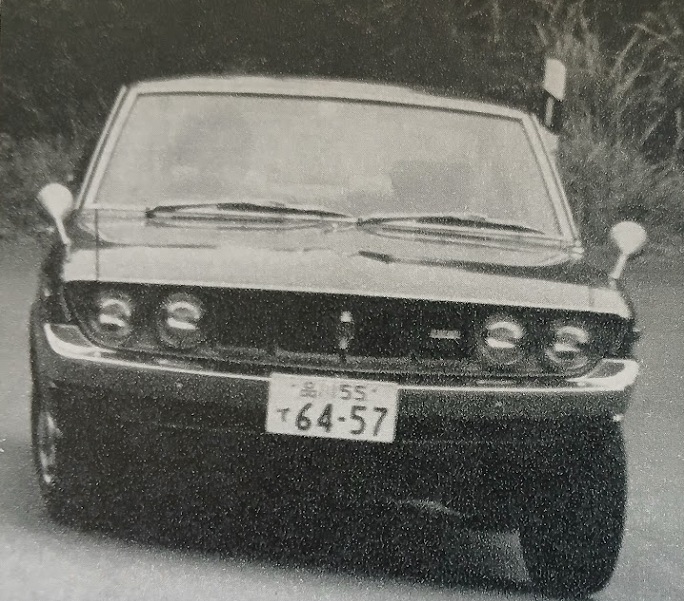Toyota Corona Mark II Hardtop GSL (1973)

Publication: Car Graphic
Format: Road Impressions
Date: December 1973
Author: “C/G Test Group” (uncredited)
Road testing the Toyota Corona Mark II Hardtop GSL
Toyota’s upper-middle-class Corona Mark II was just fully redesigned at the end of January this year, and two new variations have already been added to the lineup. One is a model with a six-cylinder engine tuned with SU twin carburetors (road impressions in the October issue), and the other is the GSL with EFI (Electronic Fuel Injection, an electronically controlled fuel injection system made by Bosch). In this EFI version, engine output and torque are increased from 115ps/6000rpm and 16.0kgm/4000rpm in the carbureted GSL to 125ps/5600rpm and 17.0kgm/4000rpm, but the main reason for adopting the EFI system seems to be to control exhaust gases, rather than to increase power.
There are two GSL models, a sedan and hardtop, and the engine is a 2.0-liter four-cylinder that is only paired with the 4-speed floor-shift gearbox. All GSLs use regular gasoline, and there is no premium-gas model. Prices in Tokyo are 51,000 yen higher for the EFI version than the standard GSL, at 871,000 yen for the sedan and 938,000 yen for the hardtop.
To test the EFI system, we borrowed a GSL hardtop and took it to the Yatabe high-speed test track with an Audi 100 Coupe S (reported on in the November issue) to perform some quick measurements of its acceleration and top speed while we conducted the full test of the Audi.
The manufacturer’s description of the EFI states the engine “wakes up” extremely well. In any case, the engine does start immediately and begins idling at a steady 1300rpm when it is completely cold. It then naturally settles to its normal idle speed of 1000rpm within a few minutes, and even if you drive off right away, it accelerates without any hesitation. The slightly fast idle remained stable throughout the test period, and we did not experience the phenomenon of abnormally higher idling speeds after high-speed driving, which often occurs with Bosch fuel injection.
In terms of performance, the engine’s ability to rev is no better or worse than that of a conventional carburetor, but the power is definitely one step ahead. For example, although the top speed did not reach the catalog data of 175km/h, our accurate fifth wheel speedometer did record a momentary speed of 172km/h (although there was a slightly strong tailwind), and it achieved 169.8km/h on a 1km straight section and 166.1km/h on average, which is close to the GSS tested in the June issue (175.2km/h on the straight section, 172.0km/h on average).
The catalog claims a 0-400m acceleration time of 17.1 seconds, which is faster than the 17.5 seconds listed for the regular hardtop GSL, but in our test it was only able to record 17.8 seconds. The engine’s power drops when it exceeds 6000rpm, so there is not much point in revving it up to the redline of 6500rpm. The maximum speeds when the engine is revved up to 6500rpm in each gear are 52km/h in first, 91km/h in second, and 136km/h in third. At the same time, the low-speed torque is not as good as expected, and the practical minimum speed in fourth gear is well above 40km/h. 0-100km/h acceleration was a fairly strong 13.0 seconds.
The engine is certainly powerful for a 2.0-liter four-cylinder, but the overall impression is similar to that of a Volvo from 10 years ago. In short, the Mark II lacks the refinement you get from recent European compact cars. The variable-ratio steering is imprecise and heavy at low speeds, and while it has excellent straight-line stability on the highway, the steering characteristics are still dominated by understeer, so the steering gets heavier as you increase your speed in corners. However, if you have enough physical strength, you can rely on the power of the EFI engine and drive it smoothly on winding roads. It’s also good at cruising on the highway, and since 100km/h is equivalent to only 3500rpm in fourth gear, even 140km/h is quite practical. The noise level is not particularly low, but there is not much difference depending on the speed.
There is no progress in the controls either. The clutch stroke is long and not light at all. The brake pedal is too high off the floor to heel-and-toe, the light and wiper switches are located low on the dashboard, as they have always been, and the switch for the power windows, which are standard equipment, is in the spot where you naturally want to place your knee to support your body when cornering, so it is easy to use by mistake. The power windows themselves are slow, and they coast for 2-3cm before stopping after the switch is released. One particularly good thing about the interior is the excellent ventilation, and even with the windows closed, fresh air blows in strongly when the fan is turned on. The speedometer is also relatively accurate, and in the range of 30 to 130km/h, it only read 1-2km/h over the actual speed.
Fuel economy was recorded at 8.7km/l over about 300km of driving, including the Tokyo-Gotemba section of the Tomei Expressway and mountain roads around Hakone and Izu. This is slightly worse than the 8.8km/l of the Audi 100 Coupe S that accompanied us on the drive, but it can still be said to be economical since it uses regular gasoline. However, we don’t think fuel economy is a persuasive factor for choosing this EFI version from the Mark II series.